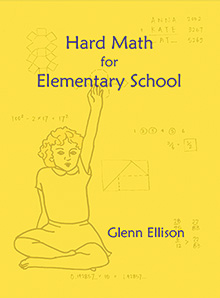Combinatorics is a fancy word for counting.

By Glenn Ellison
CreateSpace, 2013, $24.95
Doing really big problems by the partial products method gets really cumbersome and no one actually does it.
Don’t try to do this chapter if you don’t have a supply of mini marshmallows on hand.
Those are lines from a children’s math book, but there’s a reason they don’t sound like a standard-issue text. They are from Hard Math for Elementary School, a new book for upper-elementary kids who want to go further in math than their school’s curriculum is likely to take them. “The idea is to supplement what they get from regular textbooks with lessons that go much deeper into the material, ask much harder questions, and most of all, show you some of the really neat things you can do with elementary school math,” says author Glenn Ellison, a professor of economics at MIT.
Many topics in Hard Math might sound familiar at first to the average fourth grader, but Ellison bypasses the usual examples and explanations. He discusses counting in base eight using the eight-fingered characters from The Simpsons. One chapter approaches geometry via tile floor patterns from 17th-century Islamic architecture; another teaches modular arithmetic (“Have you ever thought about what life would be like if you were an hour hand on a clock?”). Ellison self-published the book (and a complementary workbook and answer key) to keep costs down and to leave him free to make it “too hard for 99 percent of the market.”
Ellison teaches courses at MIT in game theory, industrial organization, and e-commerce. But as a former math whiz kid himself (he was on the Harvard team that won the Putnam Competition in 1985), he has devoted a lot of his free time to coaching his daughters’ math teams; in 2008, he turned the study packets he had created for competitions in the Intermediate Math League of Eastern Massachusetts into the book Hard Math for Middle School.
Ellison wrote his new math book to appease Kate, the youngest of his three daughters, who’s now in fifth grade. Kate, he says, “has an innate sense of fairness” and felt that since he had published a book for her sisters, he should do the same for her. All three girls vetted the book, which is geared toward math clubs and kids who already know or very quickly learn the math being taught in class. “With this book, a group can do math on their own in the back of the room while the teacher is going over the regular curriculum,” he says. He also envisions parents reading it with their children, as few kids will be able to learn the material completely on their own.
Like the earlier book for middle school, this one is conversational in style. “I was just trying to talk to the kids as I talk to them when I’m giving a lecture,” he says. “It seemed like it worked; people liked it. So I decided to stick with that same voice, that it’s me talking to you and telling you about math.”
Recent Books from the MIT Community
From X-Rays to DNA: How Engineering Drives Biology
By W. David Lee ’69, SM ’70, integrative program officer at the Koch Institute for Integrative Cancer Research, with Jeffrey Drazen and Institute Professors Phillip A. Sharp, HM ’96, and Robert S. Langer, ScD ’74
MIT Press, 2013, $30
Brain Structure and Its Origins: Function, Evolution, Development
By Gerald E. Schneider, PhD ’66, professor of neuroscience
MIT Press, 2014, $75
The Joy of Factoring
By Samuel S. Wagstaff, Jr., ’66
American Mathematical Society, 2013, $49
Constructing Green: The Social Structures of Sustainability
Edited by Rebecca L. Henn and Andrew J. Hoffman, SM ’91, PhD ’95
MIT Press, 2013, $27
Chronicles from the Field: The Townsend Thai Project
By Robert Townsend, professor of economics; Sombat Sakunthasathien; and Rob Jordan
MIT Press, 2013, $35
Eurasian: Mixed Identities in the United States, China, and Hong Kong, 1842–1943
By Emma Jinhua Teng, associate professor of Asian civilizations and Chinese studies and director of the Women’s and Gender Studies Program
University of California Press, 2013, $27.95
The Construction of Logical Space
By Agustín Rayo, PhD ’01, associate professor of linguistics and philosophy
Oxford University Press, 2013, $55
Please submit titles of books and papers published in 2013 and 2014 to be considered for this column.
Contact MIT News
E-mail mitnews@technologyreview.com
Write MIT News, One Main Street, 13th Floor, Cambridge, MA 02142
Fax 617-475-8043
Keep Reading
Most Popular
Large language models can do jaw-dropping things. But nobody knows exactly why.
And that's a problem. Figuring it out is one of the biggest scientific puzzles of our time and a crucial step towards controlling more powerful future models.
The problem with plug-in hybrids? Their drivers.
Plug-in hybrids are often sold as a transition to EVs, but new data from Europe shows we’re still underestimating the emissions they produce.
Google DeepMind’s new generative model makes Super Mario–like games from scratch
Genie learns how to control games by watching hours and hours of video. It could help train next-gen robots too.
How scientists traced a mysterious covid case back to six toilets
When wastewater surveillance turns into a hunt for a single infected individual, the ethics get tricky.
Stay connected
Get the latest updates from
MIT Technology Review
Discover special offers, top stories, upcoming events, and more.